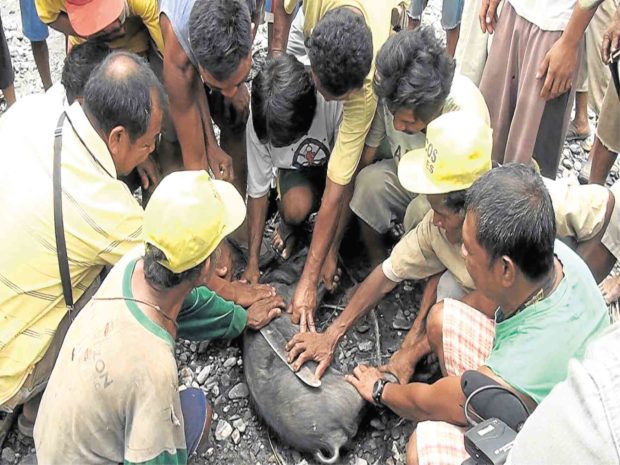
NO CURSE, PLEASE Members of the Mangyan Alangan tribe in Oriental Mindoro prepare to butcher a pig to drive away “evil spirits” that they believe may come with the completion of the hydroelectric plant project. —MADONNA T. VIROLA
CITY OF CALAPAN — Environment Secretary Roy Cimatu visited Oriental Mindoro on Friday to allay the fears of Mangyan communities over the construction of hydroelectric power projects which they said were causing the inundation of their villages during heavy rains and destroying their livelihood.
Cimatu spoke with Mangyan elders and village leaders who wanted him to order the suspension of the environmental compliance certificate (ECC) issued to Santa Clara International Corp. (SCIC), which is building the first of 13 hydroelectric power projects in a joint venture with Union Energy.
The indigenous people affected by the project were also asking for an updated risk assessment of the P1.2-billion Lower Catuiran Hydroelectric Power Plant and the 12 other planned minihydroelectric plants in the province.
After its completion later this month, the 8-megawatt Lower Catuiran plant is expected to supply electricity to Oriental Mindoro Electric Cooperative to benefit 15,000 homes.
Chief among the Mangyans’ complaints are the continued explosions and tunneling operations within the 3,000-hectare SCIC project site, which they said lacked permits from the provincial government.
SCIC allegedly disregarded an agreement with Mangyan leaders from three barangays that blasting should not be used in the project.
According to Mangyans in the towns of Naujan, Victoria and Baco, dynamites were used to create a tunnel within environmentally sensitive mountain slopes that could collapse during heavy rains.
‘Unusual floodings’
On behalf of the Alangan Mangyans, the Mission Congregation of the Servants of the Holy Spirit on July 16 sent a letter to the Department of Environment and Natural Resources to complain about the “unusual floodings” which they said have destroyed crops and livestocks.
The Holy Spirit sisters have lived and worked with the Mangyans for decades.
The Mangyans believed that the flash floods that hit their villages during Typhoon “Nona” (international name: Melor) in 2015 and the more recent landslides and floodings were caused by the hydroelectic power project.
Cimatu was told that gravel, mud and rocks that came with the floods inundated many parts of the land below the project site.
But Joseph Nuevas, project coordinator of the Catuiran Hydro PowerCorp., denied the Mangyans’ claims and said that typhoons also caused setbacks in their operations.
Mining bureau review
Cimatu said a team from the Mines and Geosciences Bureau (MGB) would look into the people’s complaints and review the project details and safety aspects of the 12 other minihydro projects in the towns of Puerto Galera, San Teodoro, Baco, Naujan, Bongabong, Bansud and Gloria.
“It is government policy to ensure that these [projects] do not pose danger [to the affected communities],” he said. “Experts will be tapped [to look into your complaints].”
Cimatu, chair of the Cabinet Cluster on Climate Change Adaptation, Mitigation and Disaster Risk Reduction, said climate change could be causing the floodings in the affected areas.
He said the more frequent and stronger typhoons, as well as the bigger amount of rainfall recently were sure signs of climate upheaval.
Joint venture
Engineer Emelyn Precioso, project manager of SCIC, clarified that the company was only contracted in a joint venture for the Lower Catuiran project.
SCIC’s task is 98 percent complete and the project will be continued by Catuiran Corp. this August, she said.
During the meeting, Cimatu instructed SCIC to “do more” to help the communities affected by floods.
He also promised to talk with the Department of Public Works and Highways about the concerns of six villages in Naujan which experienced unusual floodings when Nona struck.